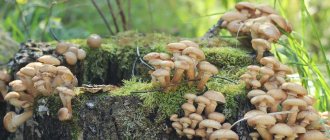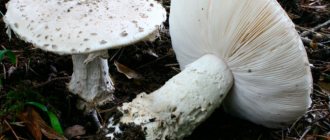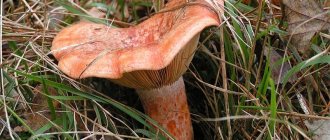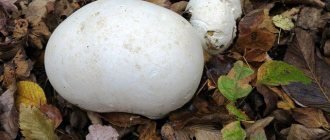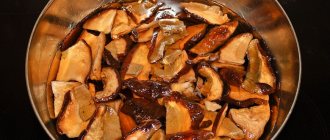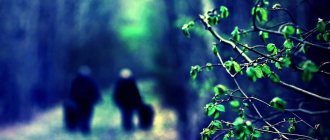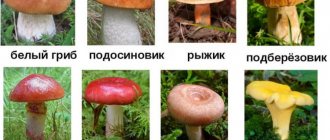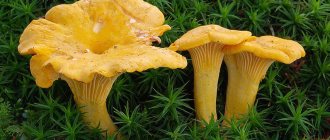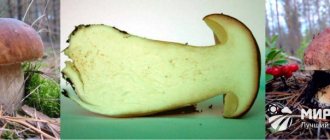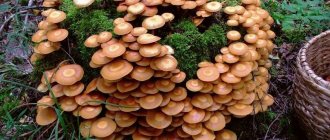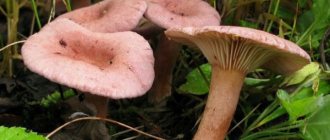Galerina marginata is one of the truly dangerous mushrooms. And not only because it is deadly poisonous, and this is exactly the case, because it contains the same group of toxins that cause death in case of poisoning with toadstool.
It is also dangerous because it has a strong resemblance to two species that are quite popular among mushroom pickers - summer honey agaric and wood honey agaric, and the similarity to the summer honey agaric often becomes the cause of tragic cases. Some experts claim that the lion's share of deaths attributed to the pallid grebe falls precisely on the fringed galerina, since the cause of poisoning is determined by the content of toxins, and they are the same in these species.
In addition, if it is not so difficult to distinguish the pale grebe from edible species, then Galerina disguises itself as a summer honey mushroom very skillfully, moreover, sometimes it grows in single specimens in the middle of a clump of mushrooms!
Therefore, it is very important to know exactly the defining signs, and to follow the golden rule of a mushroom picker - “if you don’t know, don’t take it.”
General description and photo of Galerina bordered
Galerina carinatum is a tree fungus. It has similar features to honey mushrooms. It is quite difficult to distinguish it from the summer wood and winter honey mushrooms, and it is also very difficult to find the distinctive features of Galerina marginata (from the Latin) in comparison with the autumn honey mushroom. The fruiting period of this mushroom varies from July to October, sometimes bearing fruit until the middle of the last autumn month.
hat
The diameter of the cap ranges from 0.5 -3 cm. It is defined as bell-shaped or convex, the edge is turned inward, this design is located at the beginning. Next, the cap becomes convex or almost flat, you can notice a small bump, the edges are faintly visible. The cap of such a mushroom is wet and characterized by slight stickiness; the color can be yellow-brown or reddish-brown; it can also be dried and shiny; here the colors vary from yellow to yellow-ocher-brown.
The color of the plates also varies from yellow-ocher to yellowish-brown; there is also a part where there is a reddish-brown color. The plates themselves grow widely, there is a tooth that slightly covers the stem, they are located quite often, and are narrow in width. The color of the pulp is yellow-brown, the taste and smell are flour.
Leg
It is characterized by a length of up to 8 centimeters, a diameter of 0.1-0.5 cm, a slight thickening at the bottom, and hollow. Upon closer examination, you can see a ring with a powdery coating, above it there is a white, yellowish or brown ring, below there is a fibrous coating, a whitish coating may also be present, a single-color white cap.
Edibility
Galerina fringed is classified as a deadly mushroom and contains -, - and -amanitins. There is a certain amount of consumption of this mushroom that can be considered dangerous. The liver is damaged, vomiting, diarrhea and chills begin. If timely medical attention is not provided, such food can be fatal.
Toxicity
Studies were carried out by European and American scientists, where it was discovered that phallotoxins were present in mushrooms, but the latest research did not reveal this substance. Amatoxins of fresh mushroom can vary from 78 to 270 µg/g, more poisonous than toadstool. A lethal dose of amatoxin is 0.1 mg/kg of human weight. Based on this calculation, then after eating 10 small mushrooms, a child weighing 20 kg could die. For more than 100 years, humanity has known about the toxicity of this mushroom. Fatal poisoning from this mushroom occurred in 1912 in the USA.
Mycological Difficulties
Galerina Bordered - the modest sister of the Pale Toadstool
For a long time, the species Galerina Autumnalis, Galerina Oregonensis, Galerina Unicolor and Galerina Venenata, differing from our heroine in the degree of viscosity of the cap and habitat, were considered its close relatives. But in 2001, based on phylogenetic analysis, they were all combined with it. Now they are all called Galerina Bordered. Another related species, Galerina Pseudomycenopsis, was also indistinguishable based on DNA analysis, but scientists were unable to pair it with Galerina fringed and decided to keep it as a separate species for now.
This, firstly, is a very good example of how difficult it can be for science to distinguish between various closely related species of mushrooms, which explains the scientific confusion that is often found in this matter. Even regarding the degree of toxicity of our heroine, with all her obvious danger, there is considerable discrepancy in scientific sources.
And, secondly, this is important when describing the external features of Galerina Bordered. As can already be seen, the features of the external structure and color of this mushroom can vary greatly depending on the region of growth and the subspecies to which each specific specimen of the mushroom belongs.
Similar species
Similar varieties include wood honey fungus, autumn and summer. There are some differences that will help experienced mushroom pickers avoid picking inedible mushrooms. With some species they are well expressed, but in some cases mushrooms can be distinguished by spores, which makes the process of collecting mushrooms relatively more complicated. For experienced mushroom pickers, it is difficult to confuse galerina with winter mushrooms, but beginners periodically confuse these mushrooms; this is usually due to the time of growth and the fact that sometimes these mushrooms can grow on the same tree.
Galerina marsh
The diameter of the cap of this variety is 1-3 cm, but it can change with age. The shape of the young cap is a bit like a cone, but it is convex. As it matures, the shape resembles a bell. Mature mushrooms have an almost flat cap shape, but in the center there is a pointed tubercle of a convex shape.
Under the influence of water, this part of the marsh gallery swells. The surface of the cap can be characterized as silky and smooth. Over time, the cap fades. When the mushroom is young, the hat is under a certain blanket or its whitish remains.
If we compare the cap and the stem, which is hollow inside, the stem is significantly larger in size, its length varies from 5 to 20 cm. The yellow-brown or green-yellow color of the stem can be characterized by thinness and thread-like, the diameter does not exceed 0.4 cm.
You can see a white ring at the top of the stem. The shape of the leg is smooth, sometimes it can bend. If you look closely at the leg itself, you can see the presence of a delicate flake-like coating, below - a trace of the bedspread. The characteristics of the pulp are fragility and thinness, no taste, the smell is weak but pleasant. The flesh and cap are identical in color. Either the light brown plates grow to the stem, or they fall down. With age, the color of the plates darkens. The shape of the spores is broadly ovoid.
The following areas where this fruit grows can be distinguished:
- North America;
- Europe.
Fibrous terrain, where there is a lot of moss, is the habitat of such fungi, which is why this mushroom is called marsh galerina. The plant bears fruit from June to September.
This is an inedible poisonous mushroom. If a mushroom picker does not know its features well, then you can expose your own life and your family to mortal danger, not excluding death. This mushroom contains bicyclic peptides that act slowly. These are very toxic substances.
Confused with summer honey fungus
As for the classic summer honey mushroom, it bears fruit in large clumps. Galerina has no more than two or three mushrooms if it grows in a group. There is also a difference in size between these mushrooms: the honey fungus is larger than the fringed galerina. If you look closely at the leg of the honey mushroom, you can also find significant differences: it is scaly, but not fibrous. The pulp smells pleasant, you can even detect fruity notes. The taste and smell of galerina, in turn, is inexpressive and mealy.
Precautionary measures
The similarity with the summer honey fungus (Kuehneromyces mutabilis) is so great that even experienced mushroom pickers should increase their vigilance.
- There is no need to collect summer honey mushrooms in coniferous forests, so as not to increase the chance of sending the deadly poisonous galerina to the basket.
- It is better to refrain from collecting aging honey mushrooms, because... It is their resemblance to Galerina that becomes stronger as the mushroom grows. Young mushrooms have more external differences.
- Often, near a stump or in another forest place, I find a variety of honey mushrooms nearby. Galerina can also grow among them.
Especially in moss, where the fungus feeds on decaying coniferous wood, which may even lie underground.
Habitats
Coniferous forests can be considered the most common places for this fungus. Typically, wood, stumps and the bases of trunks provide a fertile environment for the spread of this fungus. Also, protruding roots are an attractive place for galerina. Rotting saturated wood soil, moss, which is located under a layer of soil, are suitable for the growth of the fungus.
In the Russian Federation, the following places where this mushroom grows can be distinguished:
- European part;
- Crimea;
- Caucasus;
- Ural;
- Southern Siberia;
- Far East.
Growing area
Galerina fringed has spread throughout three continents, including Europe, Asia and North America. It lives mainly in mixed and coniferous forests. As a place of growth it chooses decaying wood, mainly coniferous species. Can grow in substrates located deep in the ground. Small groups of these mushrooms are found. The fruiting period lasts from August to the end of October.
Galerina bordered - difference from honey mushrooms
There is also a wood honey fungus; it is quite rare, but looks similar to the summer honey fungus. If you don’t see scales under the ring on the leg, then this will be a relative of the summer honey fungus. Only by comparing the spores of Galerina marginata and summer honey fungus can one find significant differences, because the mushrooms are difficult to distinguish. Do not confuse these mushrooms for non-office microbiologists and experienced mushroom pickers.
The photo shows a poisonous mushroom - Galerina marginata.
The autumn honey fungus is not particularly similar to the galerina, although there are cases when they are also confused. This mushroom looks quite solid, the plates are light, the flesh is thick, and the cap is scaly and grows in bunches. The confusion stems from one factor: fungal growth on wood.
Mass fruiting of the winter honey agaric occurs in a certain period, this is the difference between this mushroom and Galerina, it is completely at odds with Galerina. Winter honey fungus is also called flammulina. Galerina, which grows in November, often bears fruit on the same stump with winter mushrooms, so in order not to be mistaken, it is better to follow the recommendations.
You should not cut off one cap; it is better to collect winter honey fungus with a leg, since the gallerina on the hat can be identical to this mushroom in color. On the flammulina stalk there is dense chocolate-colored pubescence similar to velvet. It is worth paying attention to the growth of winter mushroom, it is always a large bunch, the growth can reach from 2 to a hundred or more. Here, a significant difference from galerina will be the fact that galerina, if it grows in a group, then the mushrooms still grow separately, but closely, a maximum of 2-3 mushrooms can grow together. Particular attention should be paid to the mushroom cap. In Flammulina it becomes covered with mucus or shines, when the mucus dries it is smooth. The gallerina hat is characterized by the following:
- fine-grained;
- matte;
- always dry.
As for the legs, you should also be careful here. On the leg of the galerina there is a ring or a dark winding belt in the form of a trace. The winter honey mushroom does not have this part.
The photo shows a poisonous mushroom.
Poisonous mushroom
Mushroom picking is a very exciting activity, but it requires serious attention. In our forests there is a huge variety of different types of mushrooms. Those several dozen species that are actively collected by mushroom pickers make up an insignificant part of the entire mushroom diversity. Remember that many edible mushrooms have similar-looking poisonous counterparts. When collecting noble mushrooms, we, of course, will not put fly agarics, pale toadstools, or unattractive small mushrooms in the basket, but when collecting little-known edible mushrooms, such as talkers, rowers, cobwebs, entoloms, floats, umbrellas, it is quite likely that outwardly similar species will end up in the basket which may be poisonous.
When collecting summer and autumn honey mushrooms, there is a danger of accidentally mistaking them for honey mushrooms and picking off the deadly poisonous honey fungus. To learn how to confidently distinguish edible mushrooms from poisonous ones, you need to gain some experience and have a good understanding of the species diversity of mushrooms in your region. It is also necessary to have a good knowledge of the structure of mushrooms belonging to different genera.
Dimensions of the bordered gallery.
The poison of the edged galerina (Galerina marginata) is as strong as that of the pale grebe. He is more insidious because... acts with some delay in time. There is little information about this poisonous mushroom. In most printed reference publications (especially of the Soviet era), it is mentioned extremely rarely or is considered a type of summer honey fungus.
There is an opinion that Galerina fringe began to grow in our forests recently, which is associated with some climate change. This mushroom is known in the Caucasus, many European countries, Japan, Iran and North America. Probably, there is no such passion for mushroom picking as we have there. Otherwise, all translated reference books and mushroom identification books would necessarily have a description of this deadly toadstool.
The similarity of galerina fringed with edible honey mushrooms is so great that even an experienced mushroom picker can confidently put the poison in the basket. Other types of galerina are not so dangerous, since they have the appearance of one hundred percent toadstools. Therefore, their chances of getting into the kitchen are reduced to zero. Let's try to figure out what the fringed galerina looks like, where it grows, and how poisoning manifests itself.
Galerina bordered.
Symptoms of poisoning and first aid
You can feel poisoning from this mushroom within a day, but it does not appear immediately. The first symptoms include:
- vomit;
- diarrhea;
- increased urination;
- chills.
3 days pass, the symptoms disappear. It feels like there is improvement. signs of jaundice are noticeable, liver functions are impaired, and the person dies as a result.
IMPORTANT! Within 6-10 hours, the poison is absorbed into the blood in the body.
For children, mushroom poisoning is more difficult, leading to irreversible processes. Here it is necessary to understand the seriousness of the situation. Not only the liver suffers, but also the nervous system. As poisoning increases, severe thirst and convulsions appear.
If a person touches a dangerous mushroom, it is necessary to thoroughly wash their hands and immediately treat them with an antiseptic. Fungal spores are very difficult to destroy; they can enter the body not only with food, but also through the hands.
There was a statement that in case of poisoning you need to drink alcohol, and it will help remove the poison from the body, but it is incorrect. It is necessary to immediately call an ambulance at the first symptoms of poisoning. If you do not provide it, then intoxication will increase.
First you need to take 1 tablet of activated carbon per 10 kg of weight. You also need to drink warm water with salt in the proportion of 1 teaspoon per glass. Drinking a weak light pink solution of potassium permanganate also helps. You need to induce vomiting and drink a lot of water. Ensuring rest and bed rest is mandatory, and hands and feet will need to be provided with warm heating pads.
What is botulism
The bacteria Clostridium botulinum is ubiquitous in the soil, however, due to the high demands of microorganisms on conditions for reproduction, the disease rarely occurs in humans. For example, in Moscow, about 15-20 cases of botulism are registered annually, and in Russia as a whole - no more than 200 cases per year.
For rapid sustainable growth of the population of clostridia, which is the causative agent of botulism, the absence of oxygen and a favorable temperature within 30-35 degrees Celsius are necessary. Most often, such an environment is created during home canning in a hermetically sealed jar, salting and smoking. The bacterium multiplies rapidly in the canned product, releasing a toxin abundantly. The higher the number of bacteria in a product, the more botulinum toxin it contains and, accordingly, the higher the risk of poisoning. Bacteria can also multiply in the human intestine; in this case, the disease develops more slowly.
The botulism bacillus Clostridium botulinum exists in two forms - vegetative - capable of reproduction, and spore - extremely resistant to adverse external factors. The vegetative form of the bacterium can withstand contact with sodium chloride solution, acidic environment and spices, but cannot tolerate the presence of oxygen. It can remain viable for several years, but will not withstand 15 minutes of boiling. The spore form of botulism is even more stable: it persists for several decades, can withstand up to 6 hours in boiling water, and can withstand freezing, drying, and exposure to 18% saline solution. The death of clostridia spores occurs after half an hour of autoclaving at a temperature of at least 120 degrees.
Botulism toxin has a fairly high stability: in nature it remains active for up to 118 hours, a high concentration of table salt (18%) does not have an inactivating effect on it. At the same time, the toxin is completely destroyed within 10 minutes when heated to 100 ° C and is inactivated by alkaline solutions (pH higher) and alcoholic beverages.
Are you experiencing symptoms of botulism?
Only a doctor can accurately diagnose the disease. Don't delay your consultation - call
Microscopy
A very variable species is the fringed galerina. Photos taken with a microscope confirm the fact that the spores of this fungus are the most diverse. There are variants with an adherent perisporium, and with an almost completely free one, with a pore expressed to varying degrees or with its absence.
The spores are almond-shaped, wrinkled, 7–10x5.5–7 µm in size. Pleurocystids have a fusiform shape, their neck is slightly rounded at the apex.
How to avoid infection
According to the recommendations of Rospotrebnadzor, to prevent botulism you should:
- use only industrially prepared canned food;
- Do not under any circumstances eat canned food with a bulging lid;
- wash vegetables, fruits and mushrooms well from soil particles;
- Do not use vegetable products with signs of spoilage for home canning;
- quickly remove the entrails from caught or purchased fish, wash it well, and then store it in the cold;
- do not preserve, but pickle mushrooms and vegetables;
- Before using as food, boil canned foods for about half an hour to destroy botulinum toxin.
You should know that products contaminated with Clostridium botulinum are indistinguishable from quality food in taste, color and smell. The best way to avoid poisoning is to heat treat any canned food for 15-20 minutes. This will help avoid not only botulism, but also other intestinal infections that cause poisoning and inflammation of the gastrointestinal tract.
Toxicity
Galerina fringe is a very poisonous mushroom, containing the same toxins as the toadstool. Its toxicity has been known for more than 100 years, since 1912, when the first fatal case was recorded in the United States. Then, reports of fatal galerina poisonings appeared repeatedly. Between 1978 and 1995 alone, there were 11 cases of serious poisoning, 5 of which resulted in death. The remaining six patients in Michigan, Kansas and Ohio successfully completed the therapy.
Signs of poisoning do not appear immediately, but a day after eating mushrooms. The first symptoms are vomiting, diarrhea, excessive urination and chills. After 3 days, these symptoms subside, and a period of apparent improvement begins. But soon signs of jaundice appear and the person dies as a result of impaired liver function. Often mistaken for another mushroom, galerina fringe is found in food. You can learn how to distinguish it so as not to become another victim from this article.
The toxicity of the mushroom is due to the presence of alpha- and beta-amantine toxins in it. These are bicyclic peptides, very poisonous, but slow-acting. In fresh form, the amatoxin content is 78–270 mcg per 1 gram of fruiting body, which is much higher than in the toadstool, which grows in Europe. This concentration can kill a child weighing 20 kg when eating a dozen medium-sized mushrooms.
Lethal amount of mushrooms
Galerina fringed belongs to the deadly mushrooms. It contains α-, β-, γ-amanitins. The content of toxoids in one mushroom reaches up to 270 mcg/g. At the same time, the lethal dose is 0.1 mg/kg of human weight. It turns out that if you eat several fruits, you can actually die. Therefore, it is so important to learn how to correctly identify a double.
Let's do the math:
Based on the fact that the lethal dose of amanitins is 0.1 mg per 1 kg of weight, and 1 g of fruiting body contains from 80 to 270 mg, we make a simple calculation:
1 mg = 1000 mcg;
270 mcg = 0.27 mg.
It follows that 30 mushrooms would be a death sentence for a person weighing 70 kg. You may think that you can’t eat so many mushrooms at once. But if you remember the small size of galerina, then consuming this dose is quite possible.
How to recognize botulism
The main symptoms of botulism include:
- dry mouth, nausea, change in voice, hoarseness, pain when swallowing;
- double vision, blurred vision (fog, spots before the eyes);
- drooping of the upper eyelid, dilated pupils, strabismus, ptosis;
- lack of facial expressions, pale skin, unsteady gait, poor coordination;
- symmetrical paresis and paralysis of the limbs, respiratory muscles (feeling of chest compression);
- bloating and abdominal pain, diarrhea 3-5 times a day.
If a person experiences at least one or two of the listed signs of botulism, it is necessary to immediately consult a doctor. Delay is fraught with the most serious consequences, since rapidly developing paralysis of the muscles of the respiratory system inevitably leads to the death of the patient.
Diagnosis of botulism in a medical facility includes laboratory tests aimed at detecting botulinum toxin and bacteria in the patient's vomit and blood. In addition, products that are believed to have caused poisoning are necessarily examined for the presence of a toxin.
